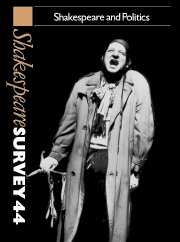Book contents
- Frontmatter
- Shakespeare and Politics
- Language, Politics, and Poverty in Shakespearian Drama
- Some Versions of Coup d’état, Rebellion and Revolution
- Woman, Language, and History in The Rape of Lucrece
- Love in Venice
- Two Kingdoms for Half-a-Crown
- ‘Fashion it thus’: Julius Caesar and the Politics of Theatrical Representation
- ’Demystifying the Mystery of State’: King Lear and the World Upside Down
- Tragedy, King Lear, and the Politics of the Heart
- The Politics of Shakespeare Production
- Shakespeare in the Trenches
- Shakespeare’s Earliest Editor, Ralph Crane
- Shakespeare’s Falconry
- Telling the Story of Shakespeare’s Playhouse World
- Shakespeare Performances in England, 1989–90
- Professional Shakespeare Productions in the British Isles January-December 1989
- Critical Studies
- Shakespeare’s Life, Times, and Stage
- Editions and Textual Studies
- Books Received
- Index
Telling the Story of Shakespeare’s Playhouse World
Published online by Cambridge University Press: 28 March 2007
- Frontmatter
- Shakespeare and Politics
- Language, Politics, and Poverty in Shakespearian Drama
- Some Versions of Coup d’état, Rebellion and Revolution
- Woman, Language, and History in The Rape of Lucrece
- Love in Venice
- Two Kingdoms for Half-a-Crown
- ‘Fashion it thus’: Julius Caesar and the Politics of Theatrical Representation
- ’Demystifying the Mystery of State’: King Lear and the World Upside Down
- Tragedy, King Lear, and the Politics of the Heart
- The Politics of Shakespeare Production
- Shakespeare in the Trenches
- Shakespeare’s Earliest Editor, Ralph Crane
- Shakespeare’s Falconry
- Telling the Story of Shakespeare’s Playhouse World
- Shakespeare Performances in England, 1989–90
- Professional Shakespeare Productions in the British Isles January-December 1989
- Critical Studies
- Shakespeare’s Life, Times, and Stage
- Editions and Textual Studies
- Books Received
- Index
Summary
In Albert Camus's The Plague Joseph Grand, a pedantic middle-aged clerk, uses coloured chalk to review the conjugations and declensions of Latin words: blue for variable endings and red for the part that never changes ('celle qui ne change ait jamais'). His reclusive neighbour Cottard, attracted by this logic, uses a piece of the red chalk to write a suicide note when he hangs himself ('Entrez, je suis pendu'). Though not as desperate or obsessive as Cottard and Grand, we historians of the theatre in Shakespeare's time have seen ourselves traditionally as the keepers of the red chalk. Unlike colleagues in criticism, whose protean theories force them to work in blue, we claim to have maintained the factual part of the discipline, the part that never varies.
We inherit this attitude from nineteenth century theatre historians who, with historians generally, took up the epistemology and methodology of the scientist. Looking through stationers' records, accounts of Court and civic offices, state papers, parish registers, and the correspondence of courtiers, the historians of Elizabethan drama came to see themselves as dispassionate observers of the natural laws that governed the evolution of the theatre in Shakespeare's time, and they conveyed the data of their investigations in the format of annals and chronicles. Charles W. Wallace epitomized the philosophy and discourse of choice in the field by the language in the title of his essay in 1910, 'Shakespeare and His London Associates as Revealed in Recently Discovered Documents'. The word 'Revealed' itself reveals the belief that the Truth about the past resides in documents from the past. All the historian has to do to find the Truth is to find and transcribe the documents, down to the last pson and occacōn.
- Type
- Chapter
- Information
- Shakespeare Survey , pp. 145 - 156Publisher: Cambridge University PressPrint publication year: 1991

